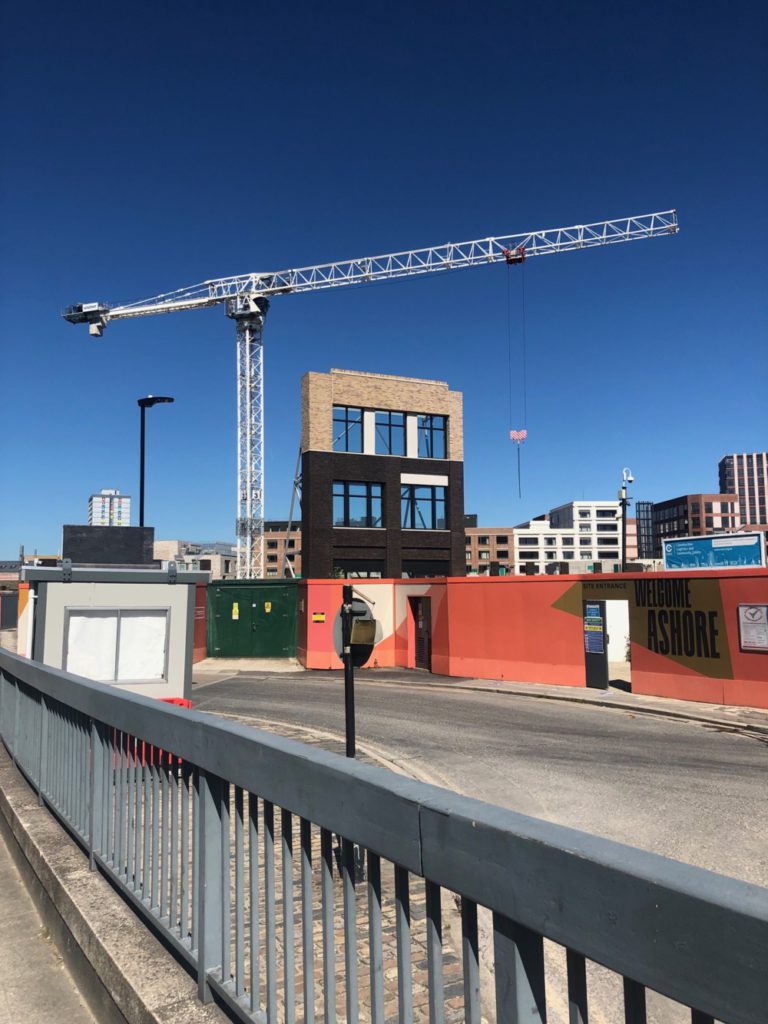Incoming from Cousin David:
Here is a pic which my daughter Molly photoed the other day when we were on a bicycle ride somewhere between Stratford and Bow – thinking that it contained elements that would appeal to you. What is curious is that the flat bit looks as if it might be part of an older building that is being preserved while new parts are built behind, but in fact it seems that it is new – and the rest of the building will be added to it. Another flat bit is going up in the background. Dashed odd!
Cousin David, to whom thanks (and thanks also to Molly), is entirely right that this photo appeals to me. As he knows, I have several times featured photos here of Ancientist facades being propped up while Modernist interiors are attached to the back of them. The triumph of Modernism but only indoors being a phenomenon of particular interest to me.
But, as he also probably knows, I have never featured a new and Modernist exterior being propped up on a building site in the same manner.
My guesses, and they are only guesses, are that, first, the standard of finish required for a building’s facade are easier to insist upon in a specialist factory than on a rather chaotic building site, and second, that having been perfected as a technique for propping up Ancientist facades, this propping up trick was then easily applied to another sort of facade. Finishing Modernist interiors in a factory makes less sense because they would be too bulky to bring in on a lorry, whereas the rectangular bits of a facade, being flat areas rather than volumes, sit quite well on a lorry. Also, once the three dimensional structure of a building is done, on site, it then protects the process of perfecting the interior, because that process can also then happen “indoors”, just as it does in a factory. (There may be a comment on this bit of this posting, mentioning a building in Croydon made of shipping containers, from the friend with whom I visited Croydon recently.)
Also, there’s a crane.
I now particularly welcome such incoming photos, what with me now being able to get out less. However, if you do send a photo in, you’ll be hard pushed to improve on the above photo in my eyes, because David realised that although I had observed this approximate phenomenon in action before, he also realised that I had probably not seen this exact version of it ever before. Certainly, if I ever have seen it, I have only now noticed it. Like I say, my thanks to him and to daughter Molly.


Oh dear – am I that predictable?! A few thoughts. A small block of flats has recently been built behind our house and it came in panels like the one David shows. Brick facade over a steel structure. They were lowered into place by crane and then bolted together. The corners were interesting, where the bricks overlap between the two walls. These were empty on the panels when they were delivered and then the corner bricks were added by a traditional brickie once the panels were in place. Also opposite the shipping container boxpark you mentioned in Croydon was this, https://www.dezeen.com/2021/05/26/hta-worlds-tallest-modular-housing-scheme-residential-architecture/ which I think you photoed. And similarly in Lewisham near where I live this: https://www.jtp.co.uk/projects/lewisham-exchange-london. Both built of 3D blocks manufactured in factories and shipped on the back of a lorry. I believe in some cases these do come with furniture elements, especially bathroom fittings, already inside. As well as having the costs and quality benefits of mass production these also may lend themselves more easily to robotic construction on site which is something a number of civil engineering firms are exploring.
Alastair
Sorry your comment got delayed. The links made my blog-software suspicious. There must be a way for me to preapprove every comment of yours, but then again, perhaps some spamster would then impersonate you and smother the place in porn links.
Anyway, the comment is up now.
I think that part of my suspicion of modular building is that Modern Movement architects have been wittering on about this for the best part of a century, during a period when building was clearly much easier done on site, with all the bits arriving by lorry.
There has been massive building innovation in recent decades, but the improvement was entirely in the form of better bits, lighter, cheaper, etc.. And, if anything, even greater separation of this bit into several bits. Insulation, to take just one example, used to be whatever you got in the building materials. Now, insulation is a distinct process, done with lightweight sheets of the stuff, which keep on getting better.
On Friday I went to a talk at New London Architecture about the London Model. The speaker commented that a renewed interest in modular building and off-site prefabrication was being driven by labour shortages due to the combined effects of Covid/Brexit in the face of continued housing shortages.
Around here on large building projects recently I’ve seen small sections of fascade propped up like that. They seem to do it as a test piece or benchmark for people to refer to when getting on with the rest of the building. In the cases I’m thinking of the test piece wasn’t incorporated into the main building though, it remained a separate (presumably temporary) propped up section with the main building going up next to it.